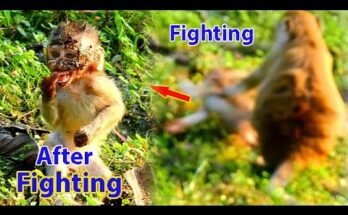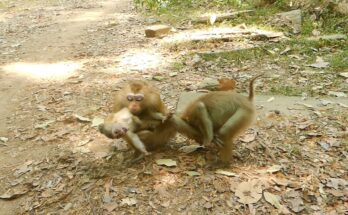In a heart-wrenching moment, a tiny baby monkey lies curled up, clearly in pain and discomfort. Once full of energy and curiosity, the little one now moves slowly, letting out soft cries as it struggles to find relief. Its small face is full of sadness, and the sparkle in its eyes has faded, replaced by tears and exhaustion. The baby monkey is sick—and everyone around can feel the emotional weight of the situation.
Its frail body shows signs of weakness; it barely lifts its head as its tiny limbs tremble. The other monkeys seem to sense something is wrong. Some approach gently, sniffing or sitting close by in silent support. But no one can replace the comfort of a mother’s touch. The baby’s cries become louder when it cannot find its mother nearby, adding emotional pain to its physical suffering. It’s a heartbreaking sight that stirs compassion in every viewer.
Caretakers or nearby humans may try to help by offering water or food, but the baby monkey struggles to accept anything. Its stomach might be upset, or it could be fighting a fever or infection. Often in the wild or in sanctuaries, young monkeys are extremely vulnerable to illness—especially when separated from their mothers or under stress. Their immune systems are delicate, and without immediate attention, things can worsen quickly.
This scene is not just about one sick animal. It’s a reminder of how fragile life can be, especially for newborn animals who rely so much on care and warmth. Watching the baby monkey cry, many viewers feel a deep emotional connection and helplessness. The pain in its eyes is real, and it’s a universal feeling any parent or animal lover can relate to.
We hope the little one receives the care it needs in time. With proper treatment, warmth, and perhaps reunion with its mother, recovery is still possible. Let this moment serve as a gentle call to care more deeply for the creatures we share our world with. Sometimes, even a small effort can make a huge difference in the life of a tiny soul like this baby monkey.


